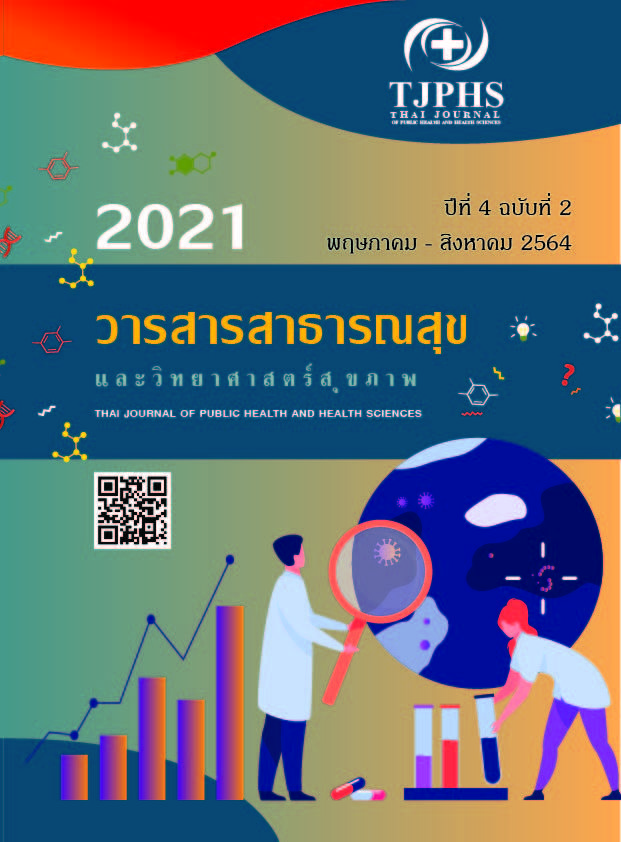รูปแบบการส่งเสริมครอบครัวอบอุ่นโดยการมีส่วนร่วมของสภาผู้นำชุมชน : กรณีศึกษาชุมชนบ้านควนล้อน ตำบลนาบินหลา อำเภอเมือง จังหวัดตรัง
คำสำคัญ:
รูปแบบการส่งเสริมครอบครัวอบอุ่น, การมีส่วนร่วมของชุมชนบทคัดย่อ
การวิจัยและพัฒนานี้มีวัตถุประสงค์เพื่อพัฒนารูปแบบการดำเนินงานส่งเสริมให้เกิดครอบครัวอบอุ่นในชุมชนบ้านควนล้อน ตำบลนาบินหลา อำเภอเมือง จังหวัดตรัง และเพื่อประเมินผลรูปแบบการส่งเสริมให้เกิดครอบครัวอบอุ่น โดยใช้กระบวนการวิจัยเชิงปฏิบัติการการวิจัยแบ่งออกเป็น 5 ระยะ ได้แก่ 1) ขั้นการวินิจฉัยปัญหา 2) ขั้นทำแผนปฏิบัติการ 3) ขั้นลงมือปฏิบัติตามข้อสรุป 4) ขั้นการประเมินผล และ 5) ขั้นระบุการเรียนรู้ร่วมกับการประเมินคะแนนความอบอุ่นและความสุขของครอบครัว กลุ่มตัวอย่าง คือ สภาผู้นำชุมชน จำนวน 12 คน โดยการสุ่มแบบเจาะจง และตัวแทนครอบครัวละ 1 คน จำนวน 30 คน ที่มีการสุ่มอย่างง่าย และมีการรวมรวบข้อมูลโดยการสัมภาษณ์ และใช้แบบประเมินครอบครัวอบอุ่น และทำการวิเคราะห์ข้อมูลด้วยสถิติพรรณนา(Descriptive statistics) และการทดสอบค่าทีคู่ (Paired t – test) ผลการวิจัยพบว่าสภาผู้นำชุมชนมีส่วนร่วม และมีการพัฒนาศักยภาพในการดำเนินการทุกขั้นตอน อีกทั้งครอบครัวมีทักษะการสื่อสาร และสัมพันธภาพในครอบครัวที่ดีขึ้น โดยพบว่าค่าเฉลี่ยคะแนนการประเมินความอบอุ่นในครอบครัว และความสุขของครอบครัวก่อนและหลังการศึกษา สูงกว่าก่อนการศึกษาการศึกษาอย่างมีนัยสำคัญทางสถิติ (t=54.161, p<.005 และ t=76.237, p<.005) ตามลำดับ ซึ่งจะส่งผลให้สมาชิกในครอบครัวอยู่ด้วยกันอย่างมีความสุข อีกทั้งทำให้ประชาชนในชุมชนเกิดการพัฒนาศักยภาพของตนเองในการดำเนินกิจกรรมต่าง ๆ ได้อย่างยั่งยืน อันจะนำมาซึ่งการสร้างความเข้มแข็งของชุมชน ทั้งนี้ควรมีการศึกษาการพัฒนาศักยภาพของแกนนำครอบครัว และควรมีการสร้างการมีส่วนร่วมระหว่างบ้าน วัด และโรงเรียนในการส่งเสริมครอบครัวอบอุ่น
References
Ratthayanaphit P., Benjawan T., Dolpraphat T. (2017). Community Participation Process in
Teenage Pregnancy Prevention. The Southern College Network Journal of Nursing and Public Health. 4(2); 256-267. (In Thai)
Wananya K. (2017). Family Relationships with Problem of Delinquency in Adolescence. Veridian
E- Journal, Silpakorn University. 10(1); 361-371. (In Thai)
Waraporn M., Chintana W., Wannee D. (2016). Family Factors Influencing Substance Abuse in
Male Adolescents at a Juvenile Vocational Training Centre. The Public Health Journal of Burapha University. 11(2); 53-63. (In Thai)
Wandee S. (2014). Participatory Action Research. Kasetsart University: n.p. (In Thai)
Thai Health Promotion Foundation. (2018). Promoting warm family in community and
Village. Unplished manuscript
Supachai T., Sane B. (2017). Participatory Development of Home, Temple and School in Problem
Solving of Young People with in Phanom Sub-district Municipality, Phonom District, Suratthani Province. Narkbhutparitat Journal. 9(2); 154-166. (In Thai)
Family education Association of Thailand. (2015). The Development Encouragement
Warmth Family innovation Project in the Target Areas. The southern region staff meeting, Hatyai. (In Thai)
Thai Health Promotion Foundation. (2018). The Healthy Family base of
Happiness’ citizen. News. Retrieved from https://www.thaihealth.or.th (In Thai)
Atiya S., Chuleeporn E., Chamaiporn C.,Orawan S. (2015). Competency Development of
Community in Caring for Persons with Hypertension: A Case Study in Surathani Province. Rama Nurs J. 21(1); 110-121. (In Thai)
Children and Youth Supporting and Development Committee. (2018, November). The 2nd
National Child and Youth Development Plan 2017 – 2021. Retrieved from
http://www.dcy.go.th/webnew/main/index.php (In Thai)
Anek K. (2014). Development of Model to Create Warm-hearted Family and Protect from
Narcotics, Khok Cha-ngai Sub-district, Mueang District, Phatthalung Province. Journal of Safety and Health. 7(26); 39-47. (In Thai) Retrieved from https://www.thaihealth.or.th (In Thai)
Arpaporn P., Surinthorn K., Sunee L., Kwanchai A. (2013). Health promotion and disease
prevention in community: An application of cincepts and theories to practice. Bangkok:
Faculty of public health, Mahidol University. (In Thai)
Akarat H. (2018). The Success of Community in Protection and Solution of Problem of Youth
Risking to Drug Addition in Angthong Province. Journal of MCU Nakhondhat. 5(2); 434-451. (In Thai)
Cecilia L., Sitna Q., Claire S. and Kate B. (2009). Understanding and operationalising empowerment
Retrieved from https://www.odi.org/sites/odi.org.uk/files/odi-assets/publications-opinion-files/5500.pdf
Rutja P., Suriyapong W., Narirat J., Manee A., Apa Y., Nittaya S.,…Ratree P. (2012). Development
Process for Sufficiency Health in Community. Journal of Nursing Science & Health. 1(35); 28-47. (In Thai)
Cheryl E. Czuba, (1999). Empowerment: What Is It?. Journal of Extension. 37(5).
Retrieved from http://www.joe.org/joe/1999october/comm1.html
Downloads
เผยแพร่แล้ว
How to Cite
ฉบับ
บท
License
Copyright (c) 2021 วารสารสาธารณสุขและวิทยาศาสตร์สุขภาพ

This work is licensed under a Creative Commons Attribution-NonCommercial-NoDerivatives 4.0 International License.
บทความทุกบทความที่ได้รับการตีพิมพ์ถือเป็นลิขสิทธิ์ของ วารสารสาธารณสุข















